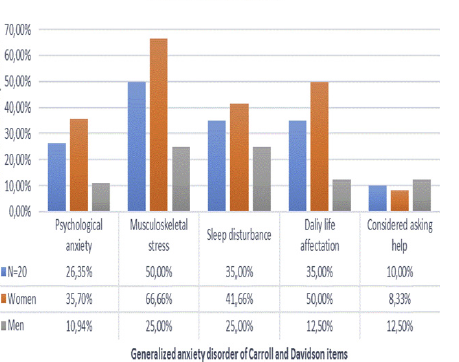No CrossRef data available.
Published online by Cambridge University Press: 23 March 2020
Disasters and emergencies generate a psychological impact on both survivors and response teams. Traumatic events and his memory would be a risk factor for anxiety disorders.
Describe the most common post emergency anxiety signs in a sample of Spanish people who responded directly to emergencies.
Study carried out by survey filled through Google Forms application; in this survey, we retrospectively value anxiety using the screening scale for generalized anxiety disorder of Carroll and Davidson.
The survey was answered by 20 people, of whom 60% were women 68.20% age range between 18–6 years and with university studies in the 70% of the interviewees. Four nurses, 2 doctors, 4 emergency assistants workers, 2 civil protection workers, 1 ambulance worker, 1 military, 3 policemen, 1 fire-fighter and 2 others. Sixty percent of cases did not received specific aid. The anxiety scale items that are most affected are musculoskeletal stress and sleep, with lower prevalence of psychological anxiety (Fig. 1). Women showed higher prevalence of psychological anxiety, muscle tension, and sleep disturbance.
The data reveals that the staff responding to emergencies recalled experienced musculoskeletal problems or sleeping disturbance better than psychological anxiety which was relegated to the background. Post-emergency treatment should be provided to all participants in emergencies including specific interventions for musculoskeletal stress and insomnia.
The authors have not supplied their declaration of competing interest.
Fig. 1
Scale for generalized anxiety disorder of Carrol and Davidson results.

Comments
No Comments have been published for this article.